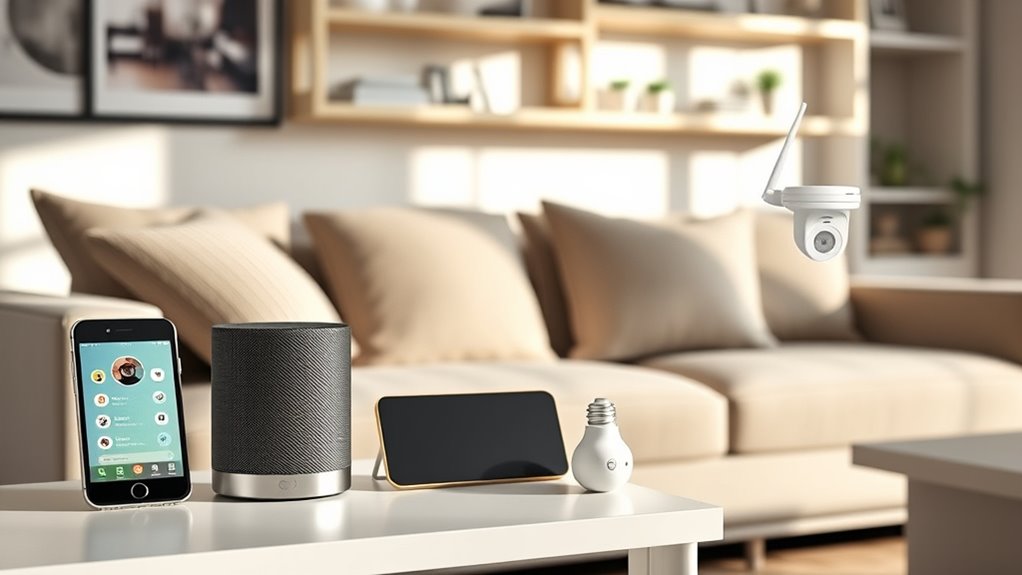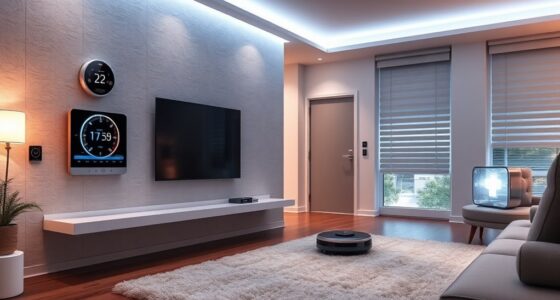To set up a budget-friendly smart home without a hub, choose affordable, compatible devices like smart bulbs, plugs, and cameras that support Wi-Fi or Zigbee. Use your existing Wi-Fi network for easy connectivity and place your router centrally. Control everything with voice assistants like Alexa or Google Assistant, and use their apps for remote management. Start small and expand gradually, ensuring all devices work well together. Keep exploring for more tips to optimize your setup.
Key Takeaways
- Select affordable, compatible smart devices like Wi-Fi or Zigbee bulbs, plugs, and sensors from trusted brands without requiring a hub.
- Place your Wi-Fi router centrally and use extenders to ensure strong coverage for all devices.
- Use voice assistants like Alexa or Google Assistant for easy, hub-free control and automation.
- Opt for devices with app-based setup, remote management, and minimal subscription fees to save costs.
- Gradually expand your system, ensuring new devices are compatible and avoiding unnecessary complexity.
Choosing the Right Budget-Friendly Smart Devices
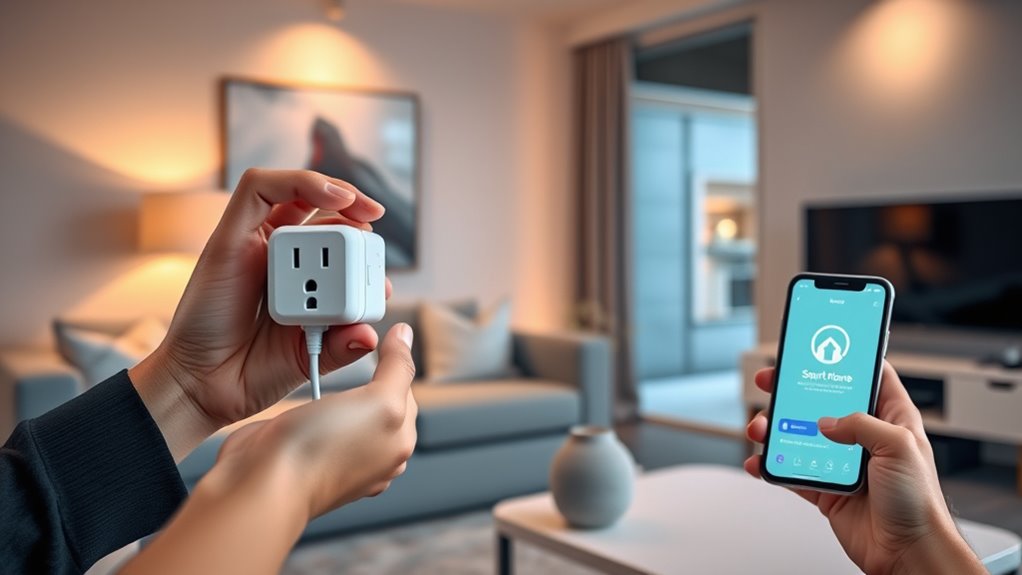
Choosing the right budget-friendly smart devices is essential to building an affordable yet functional smart home. Start by exploring reputable budget-friendly brands known for quality and affordability. These brands often offer reliable devices that won’t break the bank. Before purchasing, check device compatibility to ensure your new gadgets will work seamlessly together. Look for products that support common standards like Wi-Fi or Zigbee, so you won’t face connectivity issues later. Focus on essential devices first, such as smart bulbs, plugs, or sensors, which provide great value without added complexity. By choosing compatible devices from trusted brands, you can create a cohesive smart home setup that’s both cost-effective and easy to manage. This approach helps you maximize your budget while ensuring your devices work well together, much like selecting reliable environmentally conscious gear for outdoor activities.
Setting Up Wi-Fi and Ensuring Strong Connectivity
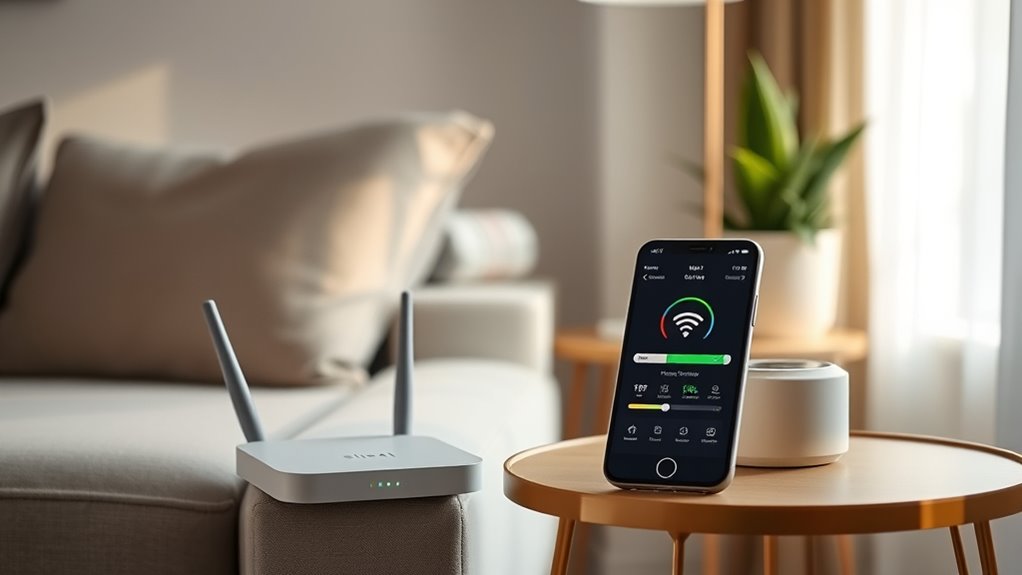
To guarantee your smart home runs smoothly, start by placing your router in a central, open spot to maximize coverage. If you notice dead zones or slow speeds, consider adding Wi-Fi extenders to boost the signal. These simple steps can greatly improve your connection without breaking the bank. Incorporating wireless technology can also help reduce clutter and improve overall connectivity throughout your space.
Optimize Router Placement
Ensuring strong Wi-Fi connectivity starts with placing your router in the right spot. Effective router placement is key to Wi-Fi optimization, ensuring your smart devices stay connected without interruptions. Position your router in a central location, ideally off the floor and away from thick walls or metal objects that can block signals. Keep it elevated on a shelf or high table for better coverage. Avoid placing it near appliances or large metal furniture, which can cause interference. Keep the router away from microwaves and cordless phones that may disrupt signals. By optimizing router placement, you’ll maximize Wi-Fi strength across your home, reducing dead zones and buffering. A well-placed router improves connectivity for all your smart devices and makes managing your smart home simpler and more reliable. Network optimization techniques can further enhance your Wi-Fi performance.
Use Wi-Fi Extenders
If your Wi-Fi signal struggles to reach certain areas of your home, adding a Wi-Fi extender can substantially improve coverage. These devices act as signal boosters, amplifying your existing Wi-Fi to eliminate dead zones. Wi-Fi extenders are affordable and easy to set up, making them a smart choice for a budget-friendly smart home. Place the extender halfway between your router and the area with weak signal, ensuring it receives a strong connection to boost. Once set up, you’ll notice improved connectivity for your smart devices, streaming, and browsing. Using Wi-Fi extenders ensures your entire home stays connected without the need for expensive mesh networks. They’re a practical, cost-effective solution to maintain strong, reliable Wi-Fi coverage throughout your smart home. Additionally, understanding headphone compatibility with various devices can enhance your overall multimedia experience.
Using Voice Assistants for Hands-Free Control
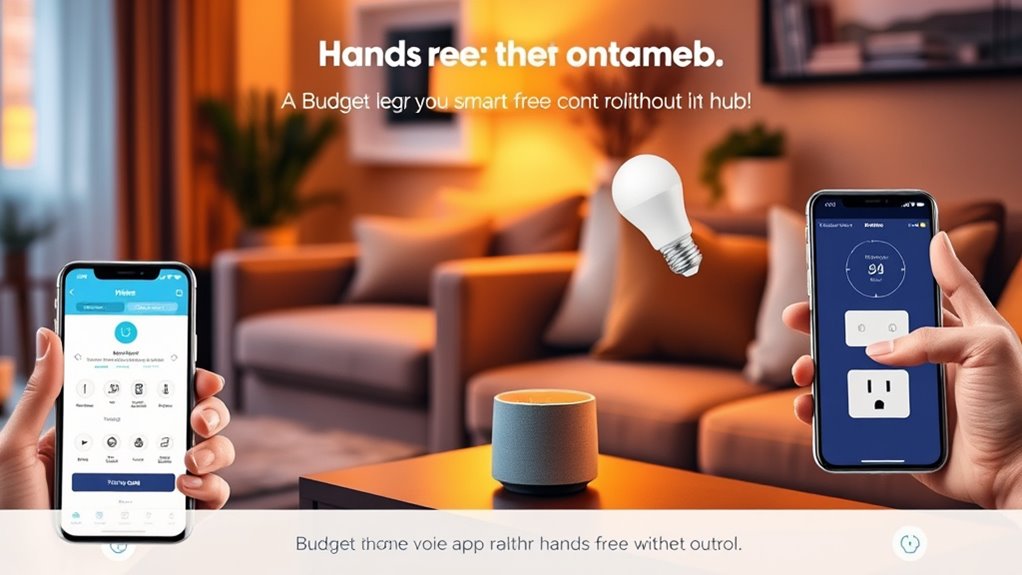
Setting up voice commands is straightforward and can instantly make controlling your smart home easier. Make sure your voice assistant works with all your devices to avoid compatibility issues. Once everything’s connected, you’ll enjoy hands-free convenience at a budget-friendly price. Additionally, integrating a top-rated projector can enhance your home entertainment experience without breaking the bank.
Voice Command Setup
Using voice assistants for hands-free control is an affordable way to make your smart home more convenient. To set up voice commands, start by choosing a compatible smart speaker, like an Amazon Echo or Google Nest. Connect your smart speaker to your Wi-Fi network and ensure it’s updated with the latest firmware. Next, enable voice command setup in the device’s app, then link your smart home devices through smart speaker integration. This allows you to control lights, thermostats, and other gadgets with simple voice commands. Be specific with your instructions to improve accuracy. Regularly review and update your device settings for better performance. Additionally, understanding essential oil blending can help you create personalized scents, adding a new layer of comfort and ambiance to your smart home environment. With this setup, you’ll enjoy effortless control without extra hubs or complicated configurations, making your smart home both smarter and more accessible.
Multi-Device Compatibility
To guarantee your smart home functions smoothly, it’s essential that your voice assistants can communicate with multiple devices from different brands. This means focusing on device interoperability, ensuring your devices work seamlessly together. Before purchasing, check app compatibility to confirm that each device integrates easily with your chosen voice assistant, like Alexa, Google Assistant, or Siri. Many budget-friendly smart devices now support popular voice platforms, making hands-free control simple and reliable. Avoid devices that require proprietary apps or extensive setup, as these can hinder smooth operation. By selecting products with broad compatibility, you’ll streamline your smart home experience and minimize frustration. Remember, a well-connected system depends on choosing devices that play nicely together, ensuring your voice commands work across all your gadgets effortlessly. Additionally, understanding device interoperability can help you troubleshoot any connectivity issues more effectively.
Automating Your Lights and Appliances

Automating your lights and appliances can considerably enhance convenience and energy efficiency without breaking the bank. With simple smart plugs and bulbs, you gain control over your devices from anywhere, saving energy and reducing costs. You can tailor schedules to match your daily routine, improving user customization and comfort. Plus, automating routines allows your devices to turn off when not in use, boosting energy efficiency even further. Incorporating stylish wall organization systems can also help keep your smart devices and accessories neatly arranged and easily accessible. Consider these options: – Smart plugs for appliances like coffee makers or chargers – Wi-Fi-enabled LED bulbs for customizable lighting – Voice commands for quick control – Scheduling lights to mimic occupancy when you’re away These methods are affordable and easy to set up, making your home smarter without a hefty investment.
Installing Affordable Security Cameras and Doorbells
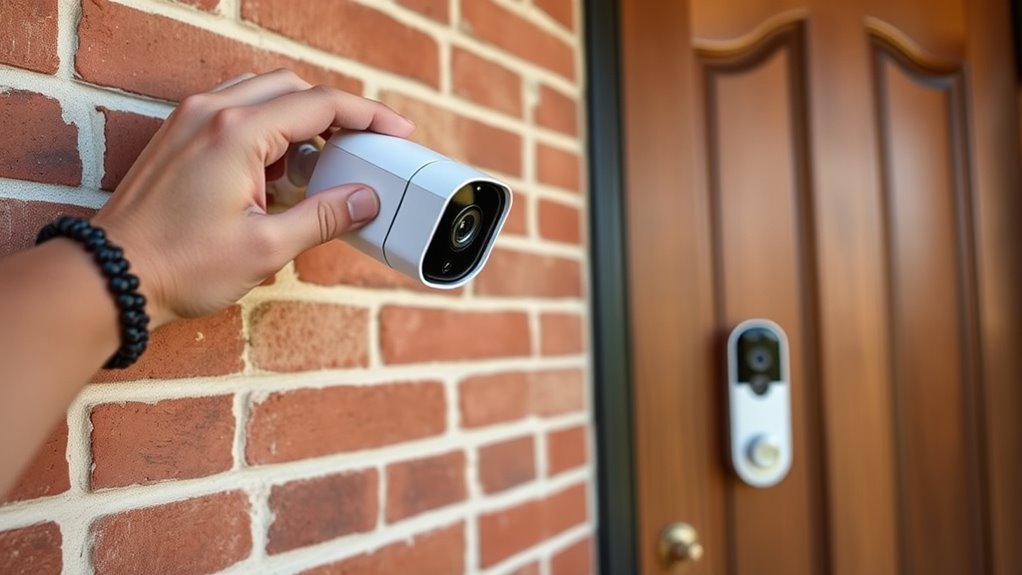
Are you looking for an affordable way to enhance your home’s security? Installing security cameras and doorbells doesn’t have to break the bank or require professional help. Many budget-friendly options offer high-quality video and easy DIY installation, making them perfect for a smart home setup without a hub. Look for wireless models with simple mounting systems and app-based setup processes. Place cameras where they cover entry points, driveways, or your backyard for maximum coverage. Smart doorbells with video streaming and two-way audio let you see and communicate with visitors from your phone. These devices often come with step-by-step instructions, so you can set them up yourself and enjoy affordable security without added expenses or complexity. Additionally, choosing systems with monthly monitoring fees or no subscription plans can further reduce ongoing costs.
Managing Your Smart Home Remotely Through Apps

Once you’ve installed your affordable security cameras and doorbells, managing them becomes straightforward with the right apps. Remote app management lets you control devices from anywhere, giving you peace of mind and convenience. Use the app to view live feeds, adjust settings, or turn devices on and off remotely. Keep your system secure by regularly updating your device firmware through the app, guaranteeing you benefit from the latest features and security patches. Many apps also send notifications for motion detection or other alerts, keeping you informed. To maximize control, explore features like scheduling or automation options within the app. Staying on top of firmware updates and managing devices remotely ensures your smart home remains secure, efficient, and easy to operate. Smart home technology continues to evolve, offering more integrated and user-friendly solutions for homeowners.
Tips for Expanding Your Smart System Over Time

Expanding your smart home gradually allows you to enhance convenience and security without overwhelming your budget. To do this effectively, focus on device compatibility. Choose devices that work with common standards like Zigbee or Z-Wave, which make future expansion easier. Before buying new gadgets, check if they integrate seamlessly with your existing setup. This ensures you won’t encounter compatibility issues later. Plan your upgrades around your needs, starting with essential devices like smart bulbs or plugs, then adding sensors or cameras over time. Keep an eye on user reviews and manufacturer updates to stay informed about device support. By prioritizing compatibility and strategic planning, you’ll create a flexible, scalable smart system that grows with your needs without costly reconfigurations.
Maintaining Security and Privacy in Your Smart Home
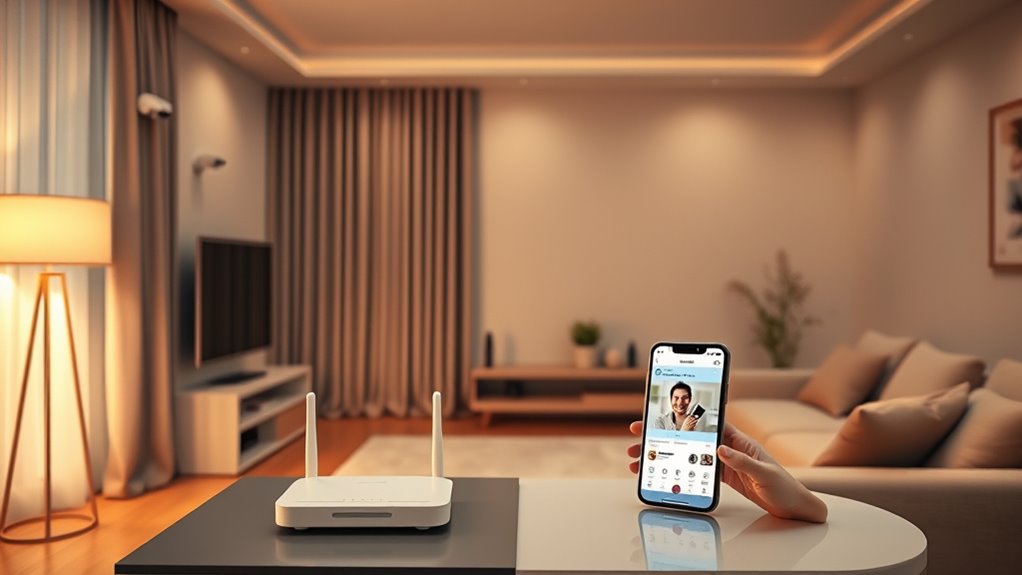
How can you guarantee your smart home stays secure and respects your privacy? First, implement strong encryption protocols to protect data transmitted between devices. Use user access controls to limit who can control or view your smart home systems, ensuring only trusted users have permissions. Regularly update device firmware to patch vulnerabilities. Disable unnecessary features like remote access unless needed. Be cautious with third-party integrations, verifying their security measures. Change default passwords immediately and use unique, strong passwords for each device. Enable two-factor authentication where available. These steps help safeguard your devices from hacking and unauthorized access, maintaining your privacy without extra costs. Staying vigilant and proactive ensures your smart home remains a secure, private sanctuary.
Frequently Asked Questions
Can I Set up a Smart Home Without Technical Experience?
You can definitely set up a smart home without technical experience. Many devices now feature user-friendly interfaces that guide you through setup steps easily. Plus, modern security protocols guarantee your data stays protected. You just need to follow straightforward instructions, use compatible devices, and take your time. With a little patience, you’ll find that creating a smart home is accessible and rewarding, even if you’re a beginner.
Are There Any Costs Beyond Initial Device Purchases?
Beyond buying devices, you’ll face few fees, but keep an eye out for additional costs. Subscription fees might sneak in for premium features or cloud storage, subtly stacking up over time. Some smart devices may require ongoing payments for enhanced security or automation options. So, while initial setup seems simple, stay savvy about these supplementary costs, ensuring your smart home stays seamless and budget-friendly without surprises sneaking in.
How Do I Troubleshoot Connectivity Issues?
When troubleshooting connectivity issues, start by checking for Wi-Fi interference from other devices or networks that might be disrupting your smart devices. Make certain your device firmware is up to date, as updates often fix bugs and improve connectivity. Restart your device and router, and move your smart devices closer to the router if possible. These steps help restore stable connections without needing a hub, making your smart home setup more reliable.
What Should I Do if a Device Stops Working?
When a device drops out or stops working, try a quick reset to refresh it. Check for firmware updates that might fix bugs and boost performance. If issues persist, power down the device, then power it back up. Sometimes, simply updating firmware or resetting the device clears glitches and gets things going again. Regularly maintaining your devices guarantees your smart home stays smooth, seamless, and secure.
Is It Possible to Upgrade My Smart Home Gradually?
You can definitely upgrade your smart home gradually. Start with scalable options like Wi-Fi-enabled devices that don’t require hubs, which makes integration easier. As you add new gadgets, consider compatibility to avoid integration challenges. This way, you can expand your system over time without a big upfront investment. Focus on devices that work with your existing setup, so upgrades remain smooth and flexible as your needs grow.
Conclusion
Building a smart home on a budget is totally doable without a hub. Choose affordable devices, keep your Wi-Fi strong, and use voice assistants to simplify control. Start small, then expand as you go—remember, Rome wasn’t built in a day. Stay mindful of security and privacy, and you’ll enjoy a smarter, more convenient home without breaking the bank. After all, a penny saved is a penny earned, especially when it comes to tech!
